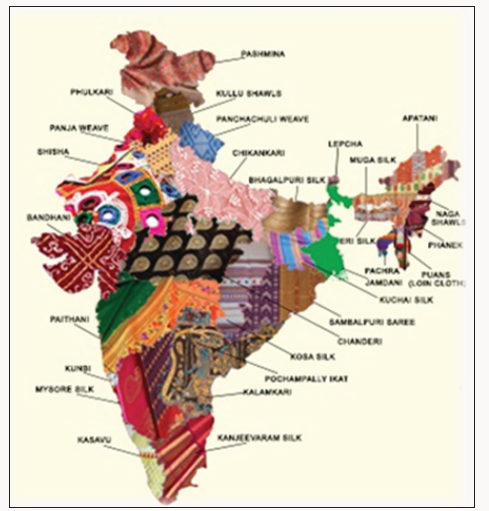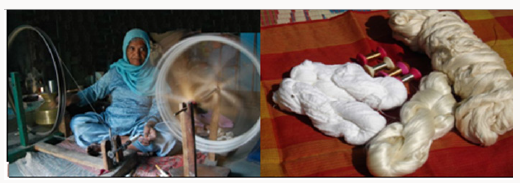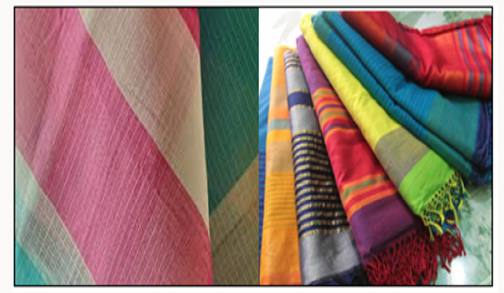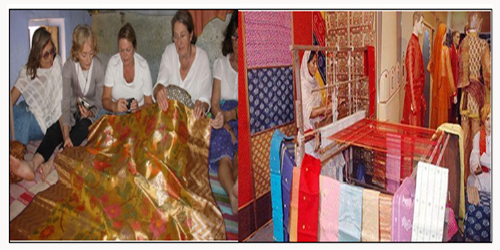
Lupine Publishers Group
Lupine Publishers
Menu
ISSN: 2637-4595
Review Article(ISSN: 2637-4595) 
Kota Doria - Weaving India through International Brocade Volume 2 - Issue 2
Ashok Athalye* and Punashi Bhatia
- Department of Colours Business, Valsad, India
Received: April 26, 2018; Published: May 02, 2018
*Corresponding author:Ashok Athalye, Department of Colours Business, Valsad, India
DOI: 10.32474/LTTFD.2018.02.000131
Abstract
Kota Doria is a hand woven fabric known for its special weaving style. The light weight and airy structure improves its wearing comfort in tropical weather while the suppleness and transparency makes it graceful and fashionable. It is made up of cotton and silk yarn of varying thickness and differing combinations in warp and weft to produce a square check patterns. The silk imparts desired gloss, while cotton provides strength to the fabric.
Keywords: Kota Doria; Cotton; Silk; Jari; Khat
Introduction
Governments has provided impetus to this industry which has resulted in almost 20 % growth in last few years. Various incentives and support schemes launched by the government in terms of technology up gradation, raw material availability, transport and logistics, marketing knowhow, export promotional opportunities, etc has provided platform for boosting sales of these handicrafts not only in India but also in the international market. Cotton, jute, wool and silk are the major textile substrates used to produce handicraft items like sari, shawl, dupatta, scarf, etc with characteristic weave, motifs, patterns and designs. The textile artisans are spread all across the rural areas of 29 states and 7 union territories within the country and each region has its unique style, design and art form (Figure 1).
Handicraft from Kota
Village cluster near Kota in Rajasthan is known for its unique weaving style to produce sari, dress material and home furnishings. Over 1,500 weaver families in Kaithun and nearby villages are engaged in making this handicraft [1]. The textile yarn or threads are called Dori in local language and the indigenous type of hand weaving practiced locally is termed as Kota Doria. Cotton and silk yarns are used for weaving a composite fabric. The inherent physico-chemical advantages of each textile substrate help enhance synergetic effect. Strength and stiffness is provided by cotton yarn while silk contributes luster and suppleness. The weaving pattern imparts a square and checkered design created by different combination of silk and cotton threads. The resultant woven fabric is translucent in appearance and adequately air permeable which is ideal for wearing it in hot and humid weather. Leading Indian and international fashion designers have recognized the worth of Kota Doria as fabric of the future and highlighted it in recent collections. The promotion encompasses apparel for men and women to accessories like handbags and pouches to home furnishings that include window coverings and lampshades. Approximately, about 6 mn meter fabric is produced per annum [2].
History and Origin
The fabric weaving style of Kota Doria is considered to have originated from Mysore, a region in South India and it moved to Rajasthan during 17th century with the migration of the weaver community [3]. Initially these fabrics were called Kota Masuri as (from Mysore), but later renamed as Kota Doria as the weaving practice became more entrenched in the Kota District of Rajasthan. Kota Masuria saris are found in a range of checks, the finest of which looks like a lentil called ‘Masur dal’ which leads people to believe that this is the root of the art form’s nature.
Material Used
The main raw materials used for Kota Doria fabric is cotton, silk and artificial zari. Combed cotton yarn of fine counts of 80s to 120s in grey un dyed or differently colored form is sourced from nearby cotton growing and spinning state of Maharashtra and Gujarat in western India. Degummed Mulberry Silk of 13 to 20 Denier is sourced from the south Indian states like Karnataka and Tamil Nadu, the Tusar Silk variety from central Indian states like Madhya Pradesh and Jharkhand while the unique Muga Silk for some specialized Sari making comes from the north eastern state of Assam. The synthetic zari is sourced from the nearby Surat city of Gujarat. This way, the Kota Doria weavers of Rajasthan are well integrated with all parts of the country.
Pre Loom Process
Many artisans prefer their own traditional hand spinning techniques to provide exclusivity. The yarn is prepared on a wooden warping frame and the length of the yarn rope is maintained at about 30 yards, for making 5 saris of 6 yards each. The width is generally 46 to 48 inches. This requires about 2400 cotton and 1800 silk yarns in the warp. The cotton yarn is strengthened by applying a mixture of rice paste and onion juice called “Maandi” as a sizing agent (Figure 2).
Fabric making
The fabric weaving is done in a square-check pattern by a combination of thick and thin yarns of cotton and silk. Such varying fiber and its thickness composition are called as Khat and such weave imparts its characteristic light weight open structure and transparent appearance. Each Khat has 14 threads composed of 8 cotton and 6 silk yarns. The conventional fabric is made by 300 to 350 Khata cross the width of the fabric and the number of ends and picks per inch result into 2400 cotton and 1800 silk yarns. The delicately hand woven fabric carries variety of patterns based on creative imagination of the weavers and further designs are created using jacquards or dobbies. Dobby is used for ground motifs while jacquards are used for making exquisite borders on the saris. Further, the aesthetic appeal is enhanced by incorporating Jari as butti or an embroidery design (Figure 3).
Coloration
Various options are available to these artisans; some procure colored yarn where the cotton substrate is dyed by Direct, Reactive or white yarn which is pre-bleached and optically brightened. Similarly, colored silk yarn dyed using Direct, Reactive and Acid dyes is sourced from the market. Depending on the class and the type of dyes used the brightness, color depth, fading |bleeding properties of the fabric varies. Some weavers prefer traditional method of coloration where the cotton yarn is dyed using natural vegetable colors or with conventional naphthol | base and Vat dyes. Sometimes coloration is done after fabric weaving to achieve either a solid uniform shade or achieve fancy effects by tie-dye, dip-dye methods. Mostly, the saris are dyed in bright colors in which red, green and blue are predominant hues.
Before coloration the yarn is pretreated with a powerful wetting agent like RUCOGEN WBL, scour-bleached using caustic soda, hydrogen peroxide, RUCO-STAB OKM as a stabilizer and RUCO-BLANC 2B as a fluorescent whitener (optional). Popularly used dyes are:
a) Tulacid|Metalan -A range of Acid and Metal Complex dyes for coloration of Silk. Covers entire hue gamut and suitable for achieving light pastel to bright vibrant shades, meeting desired color levelness and wet fastness properties.
b) Tuladir -Direct dyes suitable for coloration of both the Cotton as well as Silk. Known for their high tinctorial strength, ease of application, good reproducibility and low impact on effluent.
c) Tulathol|Tulabase -Popularly used Naphthol | Azoic coupling component and Base | Azoic diazo components for in-situ coloration of Cotton. Widely used for obtaining energy conserving, intense bright shades having excellent color fastness.
d) Tularevs Supra -Hetero-bi functional Reactive dyes suitable for coloration of both Cotton and Silk. Known for simple application method, robustness to process variables, excellent reproducibility.
e) Novatic -Vat dyes for cotton which meets most stringent fastness properties.
Further, after fabric weaving a variety of colored designs and effects can be obtained by block printing, tie-n-dye bandhani, etc for ornamentation. Details on bleaching, optical brightening and dying process, dye combination selection, fastness properties and popular shade recipes can be made available on request from authors (Figure 4).
Product Output
Sari is the most regular fabric made from Kota Doria, but now a day’s other apparel and home décor forms such as dupatta, salwar-kurta, handbag, curtain, etc are also gaining popularity. Further variation in weaving and design output is achieved by incorporating another yarn such as bamboo Rayon or any other natural yarns. A multicolored decorative effect is possible through extra threads in weft direction to increase value addition in making fancy dress material. The manufacturing of this handcrafted fabric takes more time and thus tends to be expensive compared to most fabric production obtained from power looms. It also requires high level of skill, patience and concentration. At the same time the individualised human creativity involved in hand weaving of this fabric makes it exclusive and it is possible to obtain effects |varieties which are not possible to achieve in case of mechanised fabric material (Figure 5).
International Branding
The exclusivity of handcrafted fabric has gained popularity not only within but also outside India. A wide range of fashionable garments like saris, stoles, scarves, and furnishings are made with this fabric. The delicate and porous nature of the fabric makes it more convenient for ornamentation [4]. This unique style has appealed fashion designers of global repute and is being considered for high couture and for affluent market segment. Under the Geographical Registration Act 1999, the Kota Doria Development Foundation (KDHF) has received Geographical Indication (GI) for the restricted geographical region of Kota in class 24 and 25 of handicrafts. This has helped expand foothold of this unique handicraft of India attain international recognition and value. This has helped enhance interaction of rural dwellers with the fashion designers, brands and retailers in global arena. The weavers are getting exposure to market expectations, upcoming fashion trends, end users demands, etc though their travel and attending international craft exhibitions [5-8].
Conclusion
The hand craft from a small village cluster in Rajasthan has gained international recognition owing to its unique style of weaving, wearing comfort and aesthetic appeal. The fabrics dried under the sun on bamboo poles are being worn by models on ramp during fashion shows. This has brought Kota Doria, a specialized fabric weaving style in the lime light and gets spotted on the global textile fashion arena. This has also helped as a means of socioregional transformation of the economically weaker sections of the society. The encouragement and support from the government of India in terms of various financial, skills up gradation, logistics and marketing schemes is helping artisans of Kota Doriato scale higher echelons.
References
- (2009) Fabrics from the Desert Land The Kota Doria.
- (2002) Diagnostic Study of Kota.
- Rajasthan textiles.com/Kota
- Biswas, Kritika (2010) Geographical indications in India: A Case Study of Kota Doria.
- (2017) Crafts villa takes a fabric tour of India on social media.
- Kota heritage society .in
- shop.gaatha.com
- strandofsilk.com

Top Editors
-

Mark E Smith
Bio chemistry
University of Texas Medical Branch, USA -

Lawrence A Presley
Department of Criminal Justice
Liberty University, USA -

Thomas W Miller
Department of Psychiatry
University of Kentucky, USA -

Gjumrakch Aliev
Department of Medicine
Gally International Biomedical Research & Consulting LLC, USA -

Christopher Bryant
Department of Urbanisation and Agricultural
Montreal university, USA -

Robert William Frare
Oral & Maxillofacial Pathology
New York University, USA -

Rudolph Modesto Navari
Gastroenterology and Hepatology
University of Alabama, UK -

Andrew Hague
Department of Medicine
Universities of Bradford, UK -

George Gregory Buttigieg
Maltese College of Obstetrics and Gynaecology, Europe -

Chen-Hsiung Yeh
Oncology
Circulogene Theranostics, England -
.png)
Emilio Bucio-Carrillo
Radiation Chemistry
National University of Mexico, USA -
.jpg)
Casey J Grenier
Analytical Chemistry
Wentworth Institute of Technology, USA -
Hany Atalah
Minimally Invasive Surgery
Mercer University school of Medicine, USA -

Abu-Hussein Muhamad
Pediatric Dentistry
University of Athens , Greece

The annual scholar awards from Lupine Publishers honor a selected number Read More...









